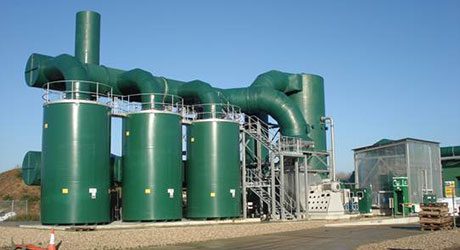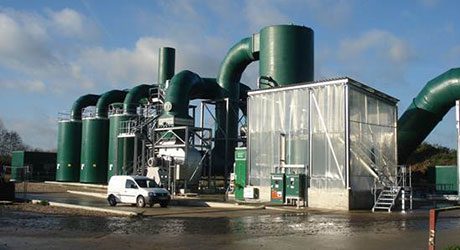ACWA AIR PROVIDES ADVANCED VENTILATION AND ODOUR CONTROL
FOR THAMES WATER AMP5 COMPOSTING BUILDING PROJECT
Air pollution control specialist, ACWA AIR, has completed a prestigious, fast-track contract to design, manufacture, install and commission Odour Scrubbing and Activated Carbon Deodoriser technology, with advanced ventilation, for the Little Marlow Wastewater Treatment Works of Thames Water.
This critical project forms part of Thames Water’s commitment to AMP5, which includes extensive improvements to process facilities at the Little Marlow WWT site. This leading UK water company was committed to begin construction of a new ventilation plant which would incorporate the “Best Available Technology”(BAT) for delivery in the early part of the new AMP5 period. In the event, ACWA AIR was awarded the contract and completed the project within an extremely compressed time-scale.
In the early planning stages, ACWA AIR was asked to provide a detailed survey of existing technologies at the site and submit design proposals for a new ventilation system which would not only increase the rate of ventilation within the composting building but reduce atmospheric odour emissions from the air-stream to less than 1000ouE/m3. The increased rate of extraction has resulted in low levels of odour within the building and a consequent improvement in working conditions for plant operatives.
In operation, odour- laden air-stream is carried inside and outside the building through more than 50 metres of ductwork, ranging from 500mm to 2000mm in diameter – effectively extracting contaminated air from the composting building to a new Odour Control System.
ODOUR CONTROL
The Odour Control System treats 135,000m3/h of contaminated air, extracted from the Thames Water composting process which is passed through a 4.2m diameter, 13m high scrubber, using sulphuric acid to neutralise ammonia in the air stream. The ammonia sulphate produced in this process is then returned to the inlet of the sewage works for biological treatment before being removed as part of the works discharge of high quality clean water into the River Thames.
The relative humidity of the airstream, after the scrubbing process, had to be in the order of 70%, to ensure that the extremely large activated carbon deodorisers perform at their highest level of efficiency. To achieve this, an in-line electric heating system was selected as being the most reliable means of conditioning the treated air from the scrubber before it passes to the three activated carbon deodorisers. Each of the three activated carbon deodorisers contains 20 tonnes of reagent which effectively remove hydrocarbons from the air-stream, using a system design which reduces both process down-time and operating costs for Thames Water and its customers. From the deodorisers, air is discharged to atmosphere through a 15m stack.
Following commissioning, independent consultants were appointed to monitor and measure plant performance over a defined period of operation – a procedure which established that the plant was not only achieving expected performance targets, but comfortably exceeding them. Environmental consultancy ADAS UK, were contracted to take samples of air discharged from the emissions stack over a period of 30 days. These were then measured in the Silso laboratories, where the odour concentration was found to be less than 500ouE/m3.

Commenting on the successful completion of the project, ACWA AIR’s Executive Director, David Harrison said: “We are pleased to be associated with the successful completion of a project for one of the most high profile water utilities in the UK -a Company dedicated to the challenging task of proactively minimising odour emissions, where necessary, from all its treatment plants. As part of AMP5, the Company is currently driving forward to install more advanced odour control at a number of its key treatment plants and we are proud to be associated with this environmentally significant work.”
The new plant is now fully operational and proving to be extremely efficient and operationally reliable – improving working conditions for Thames Water operators and securing a cleaner environment in the surrounding area.







